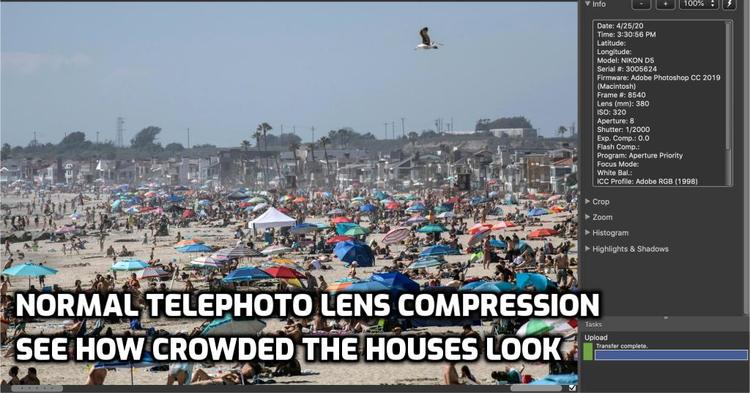
Fake Crowded Beach Photos? No, The WELL-KNOWN Optical Illusion Of Telephoto Lenses
By Steve Sailer
05/03/2020
From the Orange County Register on April 25, a photo of Newport Beach that was influential in persuading Governor Newsom to close Orange County beaches this weekend and inspired a hundred thinkpieces about the dangers of massive crowds of people flocking to the beaches and ignoring social distancing guidelines:

Three days later, the OCR printed the above version of the picture including its metadata to prove this wasn’t an old file photo:
OC beach photo: Real news sometimes stranger than #fakenews
By FRANK PINE | | Daily News
PUBLISHED: April 28, 2020 at 10:07 a.m. | UPDATED: April 30, 2020 at 3:39 p.m.… At first glance, you might think it was a file photo, because how could this be possible amid the novel coronavirus quarantine?
But the photo was indeed shot this past Saturday, April 25, from the Newport Beach pier at 3:30 p.m. Actually, if you really want to get specific, the shutter snapped at 3:30:56 p.m.
The image proved quite popular, or depending on your point view, unpopular.
In hundreds of social media posts, readers let loose with cries of “Lies! Lies! Lies!” and “#FakeNews!” Some commenters accused us of doctoring the photo (one pointed out that some of the umbrellas in the photo appeared to be the same), while others claimed we used trick photography to make the beach look more crowded.
Neither of those things is true.
Photographer Mindy Schauer, who has worked at the Register for more than 20 years, shot the photo from the Newport Beach pier with a long lens because she wanted to get as much of the beach as she could to accurately depict the scene.
Specifically, the metadata says she was using a Nikon D5 camera (an imposing professional’s model digital single lens reflex 20.8 megapixel body retailing for $5,500) and a 380mm telephoto lens. This 380 mm is probably a setting on a zoom lens such as this 17″-long $1195 Nikkor 200mm-500mm zoom telephoto lens.
I paid a lot of attention to cameras in the 1976-1986 era, but not since then so please correct me if I’m wrong.
Back then, the standard lens on an SLR was 50 millimeters, so 380 mm would be 7.6 times magnification. In the late 1970s, I had an Olympus SLR with a standard 50mm lens, plus an 80-200mm zoom lens and a 28mm wide angle lens. In the 1980s I think I had a camera with a standard zoom of maybe 38-85mm.

It was fun to play around with the different visual effects that different length lenses provided.
For example, one of my goals was to take a 200mm telephoto shot of the full moon rising over the Griffith Park Observatory while its copper domes glowed in the setting sun, which I’d seen for one stunning moment but was unable to photograph. Upon my carefully timed return, I was frustrated by thick smog.
So here’s the closest shot I’ve found on Google, but I think somebody could do better.
 In contrast, here’s a wide angle shot of the Griffith Park Observatory and the full moon.
In contrast, here’s a wide angle shot of the Griffith Park Observatory and the full moon.
This is not trickery, it’s just the laws of physics that require that a strong telephoto lens will compress distance, making distant objects look closer than they look to the human eye, which at least as of 1976 was best represented by a 50mm lens.
Nowadays with digital cameras and Photoshop, far more in the way of effects is easily achievable, but a giant 380mm lens would give you quite an effect at making a beach look crowded way back in predigital 1976.
My impression of photographers’ ethics as of 1976 was that it was not at all considered unethical to achieve an extreme perspective effect by using a telephoto or wide angle lens. It was instead considered a test of your commitment to the craft and art of photography whether you shelled out for these extra lenses. Photographers thought of if it not as distorting reality but as enhancing it. (Granted, I absorbed my photography ethics from reading magazines chock full of advertisements from manufacturers and retailers of extreme lenses.)
“It looks like a ‘Where’s Waldo?’ beach scene with all these people,” she said in a text to her editor.
She was also not the only news photographer on the beach that day. The Guardian and Newsweek have published photos similar to ours.
Okay, but shouldn’t text journalists understand the basics of photojournalism? You are paying professional photographers to bring back better pictures than what a normal person would see.
Here’s a TV newsman on KTLA pointing out that a class in Beginner’s Photography would inform you about the effects of telephoto lenses on how crowded a beach looks:
